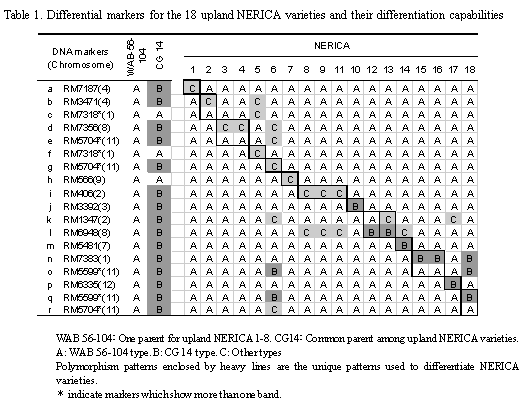Molecular markers enable identification of upland NERICA varieties
Description
Upland NERICA, New Rice for Africa, was developed by Africa Rice Center (AfricaRice, former name: West Africa Rice Development Association or WARDA) to meet increasing demand for rice in Africa. It originated from combinations between each of following three Asian rice (Oryza sativa L.), WAB 56-50, WAB 56-104, and WAB 181-18, and one African rice (Oryza glaberrima Steud), CG 14, comprising 18 varieties.
Although some varieties have identical seed morphological characters, most of them have to be observed in the field (plant morphology) to enable identification of each variety. However, plant morphology is sometimes affected by environmental factors specific to each cultivation area, making identification of varieties difficult. JIRCAS has been characterizing upland NERICA varieties based on various aspects such as agricultural traits, components and distribution of chromosome segments derived from parents or others, tolerance to abiotic stresses, and resistance to biotic stresses. The purpose is to evaluate their potential and develop new breeding materials. A survey of chromosome segments of upland NERICA varieties revealed that 18 microsatellite markers (SSR markers) enable classification of NERICA into varieties or groups.
The original seeds consisting of 18 upland NERICA varieties were provided by AfricaRice and multiplied at JIRCAS field (Tsukuba, Japan). Each variety was tested to confirm the uniformity of the plants. A total of 295 SSR markers distributed in whole genome chromosomes were used to genotype upland NERICA varieties, of which 243 markers showed polymorphism among CG 14, WAB56-104 and 18 upland NERICA varieties. The polymorphisms were derived not only from the difference between CG 14 and WAB56-104, but also from an unknown provenance. After comparing their chromosome components, 18 markers were finally selected based on their capability to differentiate upland NERICA varieties. The NERICA varieties were classified by those markers as follows: upland NERICA1, 5, 6, 7, 10, 14, and 17 were classified by their respective single markers; upland NERICA2, 12, 13, and 18 were classified by combining more than one marker (Table 1). On the other hand, the following varieties did not show any polymorphisms: upland NERICA3 and 4, upland NERICA8, 9 and 11, upland NERICA15 and 16 (Table 1). Thus, they were identified as three separate groups. This information can be used for quality control in seed production of upland NERICA varieties and their further utilization in breeding.
Figure, table
- Affiliation
-
Japan International Research Center for Agricultural Sciences Biological Resources and Post-harvest Division
- Classification
-
Administration A
- Research project
- Program name
- Term of research
-
FY 2012 (FY 2011- FY 2015)
- Responsible researcher
-
Yanagihara Seiji ( Biological Resources and Post-harvest Division )
MIERUKA ID: 001780Fukuta Yoshimichi ( Tropical Agriculture Research Front )
Namai Sachio ( Biological Resources and Post-harvest Division )
KAKEN Researcher No.: 70442720Fukuo Ayumi ( Biological Resources and Post-harvest Division )
Konisyo Kunihiko ( Nagano Nanshin Agricultural Experiment Station )
Tsunematsu Hiroshi ( Biological Resources and Post-harvest Division )
KAKEN Researcher No.: 50360392Kumashiro Takashi ( Biological Resources and Post-harvest Division )
- ほか
- Publication, etc.
-
Yoshimichi Fukuta et al.(2012). Breeding Science 62:27-37
- Japanese PDF
-
2012_10_A4_ja.pdf55.24 KB
- English PDF
-
2012_10_A4_en.pdf127.99 KB

